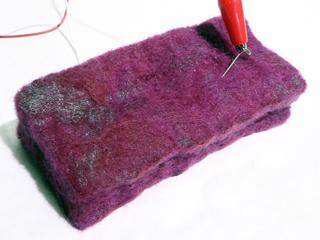Thomas Gerhardt
Felt Resistor
Sink your fingers into a variable resistor made out of felt.
http://thomas-gerhardt.com/itp/FeltResistor/

Classes
The Softness of Things: Technology in Space and Form
The Softness of Things: Technology in Space and Form
Why can't buttons, knobs, and sliders be more tactile and organic? As our world gets more and more digital, and inevitably more seamless, what will happen to the heirloom... or your pair of trusty-rusty leather boots. When the objects in our lives are all made out of materials like plastic and glass, which we fear to scratch, how will we relate to them-imprint ourselves into them.
Felt, besides having great utility (water-proof, insulation, etc), is a soft, spongy, and very durable material; so, I thought it would be a great candidate for making a soft interface to electronic components that would stand the test of time, wear, and become part of you... like the scratches on an old belt. By 'felting' together natural wool and steel wool, in a process I developed, I was able create conductive felt. Because the steel wool has resistivity, a block or any volume of the conductive felt can be used as a variable resistor, and thus an flexible and deeply haptic interface to electoronics.
For the Winter Show, I will install a long block of conductive felt (3-4ft x 4in x 2in) preferably in a hallway or other passage. The felt will have an array of electrodes embedded in it every six inches. Each electrode acts as a variable resistor (reacting to pressing and bending) that controls one LED in an array placed directly above the conductive felt strip. People will be invited to touch, squeeze, press, bounce, the Felt Resistor and re-experience electronics in an organic and human way.
Felt, besides having great utility (water-proof, insulation, etc), is a soft, spongy, and very durable material; so, I thought it would be a great candidate for making a soft interface to electronic components that would stand the test of time, wear, and become part of you... like the scratches on an old belt. By 'felting' together natural wool and steel wool, in a process I developed, I was able create conductive felt. Because the steel wool has resistivity, a block or any volume of the conductive felt can be used as a variable resistor, and thus an flexible and deeply haptic interface to electoronics.
For the Winter Show, I will install a long block of conductive felt (3-4ft x 4in x 2in) preferably in a hallway or other passage. The felt will have an array of electrodes embedded in it every six inches. Each electrode acts as a variable resistor (reacting to pressing and bending) that controls one LED in an array placed directly above the conductive felt strip. People will be invited to touch, squeeze, press, bounce, the Felt Resistor and re-experience electronics in an organic and human way.
